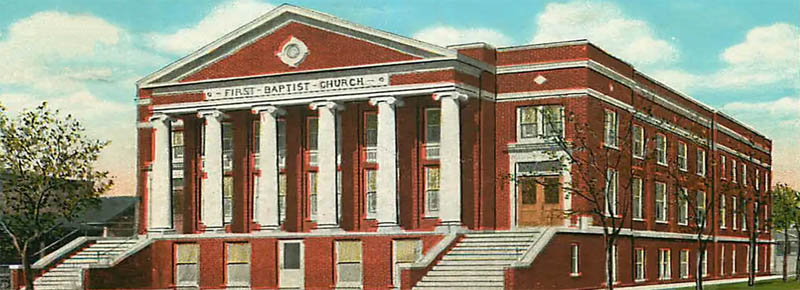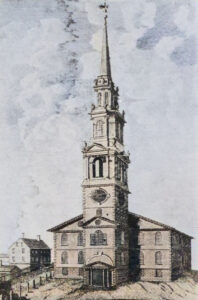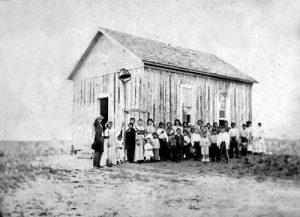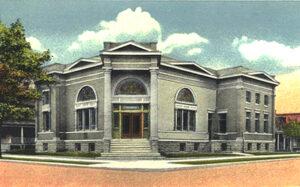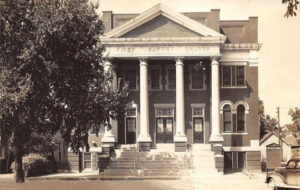The name Baptists was given to members of congregations who had withdrawn from the dominant churches of England and restored what they believed to be apostolic principles. This name was first applied in England around 1644, and the people forming the organizations maintained that immersion upon confession of faith was necessary for valid baptism, rejecting infant baptism as incompatible with regenerate membership. Other religious bodies had practiced immersion without such teaching.
From the first, there were two branches of English Baptists: those who followed the teachings of Calvin and those who adopted the theology of Arminius. The Arminian, or General Baptists, formed first under the leadership of John Smith, who established the first General Baptist church in London in 1611. The Calvinistic or Particular Baptists originated from a congregation of Separatists established in London in about 1616. One of the first principles of the Baptist organizations was that the church as a spiritual body should be entirely separated from the state and that spiritual liberty be extended to all — Catholic, Jew, and Protestant.
Roger Williams established the first Baptist church in America in Providence, Rhode Island. He was a minister of the Church of England, but soon after leaving the University of Cambridge, he adopted separatist principles. He sailed for America in 1630, hoping to find religious liberty in the new world. Landing in Boston, Massachusetts, he was invited to preach in the established church but refused as it was unseparated. After some time, he finally located with the separatists of Plymouth colony. Because of his teachings, Williams became a disturbing element, and he was condemned to banishment and deportation to England in 1635. He managed to escape and went through the wilderness in midwinter to the Narragansett Indians, of whom he bought land and founded the colony of Providence on the principle of civil and religious liberty. He advocated the most complete separation of church and state at a time when such ideas were almost inconceivable.
In 1639, a small band of only 12 believers originated baptism and the first Baptist church. In about 1640, a Baptist church was formed at Newport, and in 1655, a church of this belief was established in Boston and maintained despite opposition. A colony of Welsh Baptists came to America in 1665, and after some difficulty, they were located at Rehoboth, Massachusetts, in 1667. By 1750, there were eight Baptist churches in New England.
The Baptists began to locate in New Jersey and Pennsylvania after 1682, and, as there was tolerance of religion, many Quakers and Baptists emigrated from England to these localities. In 1686, several Baptist families from Wales located on the Pemepek River, where and a year later, a company organized a church. The same year, a church was organized in Middletown, New Jersey, and by 1770, twelve such churches existed. Services were held in Philadelphia, Pennsylvania, under the auspices of the Pemepek Church from 1687, but the first church was not organized until 1698. The Philadelphia association was organized in 1707, and the New York colony churches sought admission to it, as did the churches of Virginia and the Carolinas. Gradually, the church became firmly established in Massachusetts, Rhode Island, New Jersey, Pennsylvania, New York, North and South Carolina, and Connecticut, and a few congregations were organized in Virginia. During the Revolutionary War, the progress of the church was not materially checked, and it is estimated that in 1792, there were 1,200 organizations with a membership of 100,000.
The great westward migration after the American Revolution was an opportunity quickly improved by the Baptists. Missionary preachers were sent to the new Western country, and Baptist societies formed on the fringes of civilization. In 1845, differences arose over the question of slavery, and the churches of the slave states formed the South Baptist Convention, while the northern churches organized the American Baptist Union. At different times, branches have separated from the two original Baptist organizations or new congregations were formed until the church included the following bodies: Northern Baptist Convention, Southern Baptist Convention, National Baptist Convention (Colored), General Six-Principle Baptists, Seven-day Baptists, Free Baptists, General Baptists, Separate Baptists, United Baptists, Duck River and Kindred Associations of Baptists (Baptist Church of Christ), Primitive Baptists, Colored Primitive Baptists in America, Two-Seed-in-the-Spirit Predestinarian Baptists, Freewill Baptists (Bullockites), and United American Freewill Baptists (Colored).
The Baptist church was one of the first religious organizations to begin work in Kansas, for as early as 1831, Baptist missionaries were sent among the Indians. In July of that year, Dr. Johnston Lykins came to the Indian Territory and, at his own expense, bought a small tract of land contiguous to the Shawnee Indians, who were located on the Neosho River at that time. The following year, 1832, he was authorized by the Baptist board to erect mission buildings. In 1833, Lewis Cass, the Secretary of War, authorized him to visit various tribes west of the Mississippi River and report upon favorable sites for missionary establishments. In 1835, he was ordained and given special charge of the Shawnee and Delaware Indians. In June 1837, the Ottawa Baptist Mission was established about five miles northeast of the present site of Ottawa, in Franklin County, by Jotham Meeker and his wife, who had been missionaries to the Shawnee. In 1842, a large mission house was erected, and a school was established for the Indian children.
The first missionary to the Potawatomi Indians in Kansas Territory was the Baptist missionary Robert Simerwell. In 1837, as soon as this tribe located at their new reservation on the Osage River, Mr. Simerwell and his wife located among them, and when the Potawatomi removed to their reservation on the Kansas River, the Baptist mission was established in what is now Mission township, in Shawnee County. This became one of the largest and most prosperous missions in the territory. In 1840, David Lykins established another Baptist mission in Miami on Wea Wreek. Nearly all missions were maintained until the territory was thrown open to white settlement, and the Indians were transferred to the Indian Territory (present-day Oklahoma).
When the Territory of Kansas was organized and thrown open to white settlers in 1854, most of the first immigrants were men who had belonged to churches in the east, and one of the first things they did upon establishing their homes was to organize churches where there were enough people to form congregations. Being among the first missionaries, the Baptists were among the first to form permanent organizations. Less than a year after the first settlers located in Lawrence, Kansas, the Baptist Church was organized there by William W. Hall. The services were held in private residences and halls until 1870 when a church building was erected. The Baptists were also among the pioneer religious organizations established in Nemaha County. The first sermon was probably preached in the county by Elder Thomas Newton, who came from Illinois in 1854. He ministered at Central City and later at Seneca.
The first church society was organized at Central City on August 1, 1857, and the first pastor was T.R. Newton. A small church was soon erected, which was used as a schoolhouse during the week. The first religious services were held by the Baptists in Doniphan in 1855. A church was erected quickly, and Mr. Anderson became the first minister. As early as 1856, John Williams, a Baptist preacher, held outdoor services at Trading Post in Linn County, where a church was organized early. In Shawnee County, a church was organized at Topeka on March 1, 1857, with R.M. Fish, the first preacher. The first Baptist church in Osage County was organized on August 6, 1857. During the first year, the church was served occasionally by R. C. Bryant and J. B. Taylor, but no church building was erected until 1869. In Atchison, a Baptist church was organized on August 1, 1858, and the first minister was Mr. Anderson. A Baptist organization was formed in Manhattan, Riley County, on August 14, 1858, and it was incorporated on November 13, 1860, with M. L. Wisner as the first pastor. In the fall of 1858, the Tabernacle Baptist church was organized at Leavenworth by Mr. Kermot. The First Baptist church was organized in 1860 1864; the two were merged to form the Baptist church, for which a building was erected in the early 1860s. In October 1859, a Baptist congregation of seven members, one of the pioneer religious organizations in Lyon County, was organized at Emporia by R. C. Bryant. The Baptists were the first to effect a church organization in Clay County at the Huntress’ cabin, and the Clay Center church was organized in August 1868 with twelve members. Elder A.H. Dean started the first Baptist church in Miami County on February 25, 1860, with 20 members. It became the leading church of Paola, a building being erected five years later. H. S. Tibbits organized the Baptist congregation at Hiawatha on August 18, 1860, with fifteen members, and it soon began to be one of the leading religious organizations of the locality. The work of the Baptist church was started in Franklin County by the Indian mission in 1837, but the first church was organized in 1864 at Ottawa. This church adopted the New Hampshire Confession of Faith and held meetings in a building until a church was erected the following year. Religious services were held at Fort Scott, Bourbon County, while it was a military post, but the Baptists did not effect an organization there until February 18, 1866.
In 1868, a church was organized at Salina by J. R. Downer with 15 members, and a church was erected quickly. An organization was perfected in Neosho County in 1869 with seven members by Elder A.C. Bateman, who was chosen as pastor. Services were held at the Erie schoolhouse until a church was erected in 1871. Cherokee County was not opened to white settlement until 1870, when a Baptist church was organized at Columbus with 12 members on March 20 by Elder A.C. Bateman, and the first pastor was Mr. Maver. According to the census of 1875, there were 286 church organizations in the state, with 36 church buildings and a membership of 12,197. By 1878, the organizations had increased to 334, with 69 churches and 16,083 members, and by 1890, there were 358 organizations, 263 churches, and 32,689 members. In 1906, the Baptist church ranked third in Kansas in the number of members of all Protestant and Catholic denominations, having 46,299 members.
Compiled and edited by Kathy Alexander/Legends of Kansas, updated March 2024.
About the Article: The text in this article comes from Kansas: A Cyclopedia of State History, edited by Frank W. Blackmar and published in 1912. However, the story as it appears here is not verbatim, as it has been edited for clarity and the modern reader.
Also See:

